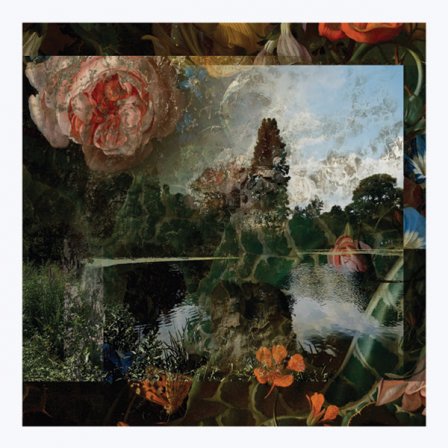J. G. Biberkopf and Joe Hamilton — the creator of Ecologies’s artwork — operate in a similar vein. Namely, both take the systematics of landscapes as a basis for their work. In Landscape Heterogeneity and Disturbance, Monica G. Turner (2012) describes a typical rural landscape, made up of “several agricultural croplands, pastures, woodlands, streams, farmsteads, and roads.” By the same token, Hamilton’s Hyper Geography — a definitive art piece embedded within the framework of Tumblr — offers its own landscape, described by Dominikus Müller of Frieze d/e as “a dense, inextricable jungle of fractal patterns, visual noise, images of hands, faces, eyeballs, robots, cameras, all manner of digital gadgets, contorted architecture and, again and again, plants, leaves, grass, sky, mountains and minerals.” Biberkopf’s Ecologies, meanwhile, is composed of field recordings, chops of club music, digital shards, ambient drones, and short vocal utterances. To describe its contours, it would probably be angular and jagged, with sharp corners and slightly skewed.
While a landscape can be defined as an expanse of scenery, comprising recognizable objects, the relations and interactions are what’s at stake here. This emphasis is consistent with a shift of focus away from text and toward the overriding texture — in other words, from specific organisms to entire ecologies. Indeed, much of contemporary art has been occupied by symbolic reference. In visual art, you can see an obsession with signs and their weight in meaning, whether brand logos or the body parts and technological devices that adorn Hyper Geography. Similarly in music, Simon Reynolds in particular has acknowledged the infatuation with referential meaning, such as nostalgic value in Retromania: Pop Culture’s Addiction to Its Own Past (2011). With Ecologies, however, Biberkopf projects a universe as Hamilton does, in which each object points to all others. In Ambient Natures, Müller submits that the shift imports an immersion — or merging — of subject and object:
As the text becomes texture, past culture is taken up by an always present nature; indulging in memory and nostalgia is replaced by immersing in an environment, if not merging with it; distinct breaks, cuts and revolutions become the slowly but steadily changing continuum of evolution.
Levi Bryant’s The Democracy of Objects (2011) is a useful resource to comprehend such a mergence. Specifically, Bryant proposes that, contrary to a reduction, “subjects are objects among objects, rather than constant points of reference related to all other objects.” As a consequence, he states, we get to “what anti-humanism and post-humanism ought to be, insofar as these theoretical orientations are no longer the thesis that the world is constructed through anonymous and impersonal social forces as opposed to an individual subject.” What we then get, he suggests, is “a variety of nonhuman actors unleashed in the world as autonomous actors in their own right, irreducible to representations and freed from any constant reference to the human where they are reduced to our representations.” In fact, talking to Umea Universitet, Bryant argues that we should not think of objects in terms of their qualities or properties, but rather treat objects as activities or powers; we should resist asking what a thing is, and ask instead what it does. Objects, in this sense, can be classed as machines within a mechanic ecology.
On Ecologies, Biberkopf places objects with otherwise essential properties in a synergy whereby each affects the properties of the rest. The guttural grime on “Age of Aquarius” is transfigured by distant scenic sounds, which in turn shift gears in relation to distorted, intrusive voices. Sure, the very shift toward natural systems affords its own symbolic obsessions, influenced by the aesthetics of nature itself. Hence, visual trends arise in the direction of plant life and geo-imagery, and a corresponding aural preference for their sonic equivalents. Here, this is is exemplified by field-recordings, sounds of water and air, and images of the natural world interwoven on Ecologies’s artwork. Likewise, it can be found in the track titles: “Air. Coltan. Carbon. Lithium.,” “Waters,” and “Black Soil.” However, the sheer aestheticism of these elements seems the result of new underlying conditions. And similar a flux of producers creating like-minded works with an acute net-awareness — Sentinel, Ornine, v1984, Mind: Body: Fitness, Djwwww — the aestheticism ultimately points to one dominant landscape in particular — the internet — which, through its network of hyperlinks, connects otherwise unrelated objects, creating neoteric categories, genres, aesthetics, and landscapes in the process.
More about: J. G. Biberkopf

